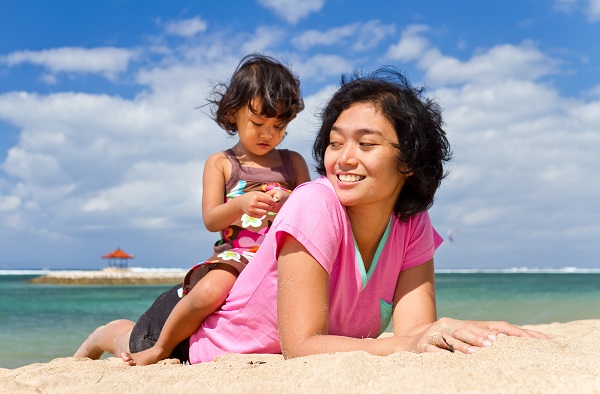Spring Break Safety Tips
The cold, dark days of winter are getting old by this point, which makes spring break a great time for the family to get away for some fun in the sun! Keep your family safe while on your trip by following these tips from the American Academy of Pediatrics (AAP).
Sun safety for babies:
- If your baby is under 6 months of age, keep her or him out of direct sunlight as much as possible. Move them into the shade of a tree, under an umbrella, or use a stroller canopy. Dress babies in lightweight clothing that covers the arms and legs, and don’t forget a brimmed hat!
- If there is no way to avoid the sun, it is okay to apply a small amount of sunscreen on infants under 6 months. Remember though, it takes 30 minutes to start to work!
- For tips on choosing a sunscreen, check out our Sun Safety Tips
Sun safety for older kids:
- Select clothing that is made of tightly woven fabrics. For clothes that are both cool and protective, try cotton clothing.
- Hats are great! Try and find one with a wide brim to shade the cheeks, chin, ears, and the back of the neck.
- Don’t forget their eyes! Sunglasses with UV protection are also good for protecting your child’s eyes.
- Apply sunscreen to the areas not covered by clothing, but test the sunscreen first for signs of an allergic reaction (try a small amount on the child’s back before slathering it on everywhere). If a rash develops, talk to your pediatrician.
- Apply sunscreen carefully around the eyes, and avoid the eyelids.
- If your child gets a sunburn that results in blistering, pain, or fever, contact your pediatrician.
Sun safety for the whole family
- The sun’s rays are strongest between 10am and 4pm; if possible, keep out of the sun during those hours.
- Sunlight can bounce off of sand, snow, or concrete and increase the amount of rays that you are exposed to. Be particularly careful in these areas.
- Sun protective clothing is commercially available, such as in swim shirts.
- Use sun protection even on cloudy days – the sun’s rays can come through the clouds!
- Sunscreens should be used for sun protection, and not as a reason to stay in the sun longer.
- For tips on choosing a sunscreen, check out our Sun Safety Tips
Tips for the beach:
- Never swim alone, even if you are an adult
- Anytime that a young child is in or near the water, provide touch supervision and ensure an adult is within arm’s reach.
- In other countries, pools and beaches may not have lifeguards, and pools may have unsafe drain systems. Please supervise children closely.
- Stay within the designated swimming area, and ideally within the visibility of a lifeguard.
- In case of a storm, seek shelter and get out of the water. If there is lightning, leave the beach.
- Some beaches allow cars, so watch for traffic
- Be aware of rip currents. If you are caught in a rip current, don’t swim against it. Swim parallel to the shore until you are clear of the current.
A note about tanning salons: While many teens and young people go to tanning salons, the UV radiation from tanning in this fashion still raises a person’s risk of developing skin cancer, including the most dangerous, melanoma. Tanning salons are not safe, and the AAP recommends prohibiting access to artificial tanning devices by children under the age of 18.
Source: https://www.healthychildren.org/English/news/Pages/Spring-Break-Safety-Tips.aspx


